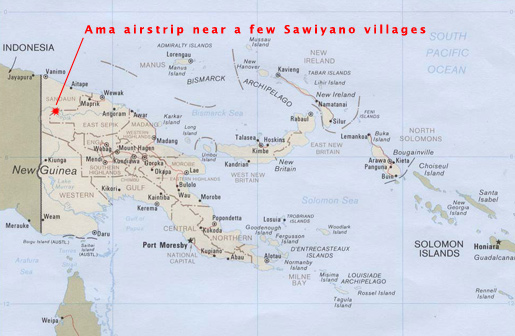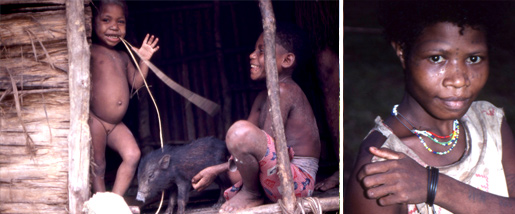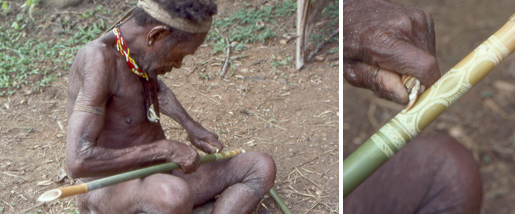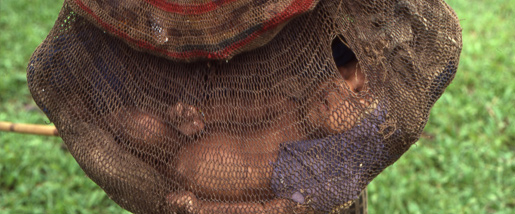ABOUT THE FILM
Video Clips can be found on the home page.
The Story Behind the Project
Near the border between Irian Jaya (now called West Papua since 2007) and Papua New Guinea lives a tribe called the Sawiyano. They have been in contact with outsiders since World War II. When I was growing up there, I heard stories from the old men and women of how scared they were when planes flew over the village for the first time. Soon after, about a half-day walk away from Sawiyano territory, near a tributary of the great Sepik river, Japanese introduced a few Sawiyano to the outside world.

Eventually, the lure of steel axes and machetes led a few Sawiyano to plantations where they were hired as cheap labor. The men eventually brought back goods like matches, salt, and knives. The Australian government came in to the area in 1965 and soon put an end to the cannibalism by placing perpetrators in jail. A small airstrip was cleared and the first missionary arrived in 1973. Soon after in 1975, Papua New Guinea claimed independence. The PNG government officials left the area in the early 1990s.
Some Sawiyano learned to read and write in the short-lived government school at the airstrip and missionaries also taught literacy. Through the last 50 years, many things have changed in the tribe. Cannibalism was abolished, tribal rivalries and fights were mostly stopped. Houses are no longer as high off the ground when fear of attack was prevalent. Some tribe members adopted a new religion, others continue to follow the old ways, while some mix a new faith with the ancestral traditions.
Despite the changes, many old ways of the tumbuna (ancestors) continue, especially in regards to crafts. Food is gathered in a similar manner each day as it was 50 years ago. Some houses now have some nails but the main traditional methods are still utilized. Bilums are the traditional bags of the country and they are still made by the Sawiyano, both with natural fibers and imported thread.

Having grown up in the Sawiyano tribe, I have an understanding of and deep appreciation for the traditional ways. Since earning a BFA and MFA in Painting and Drawing, I have an even greater respect for the arts and craft of the Sawiyano. Because the culture is changing, I know it is important to capture traditional elements on film and in photos before more elders die. I have permission from the elders of the Sawiyano to film their lives. They have the final say in the content of the film.
Not only is the documentation for the future generations of Sawiyano, but I hope this will others to gain an appreciation for the Sawiyano culture and to develop an interest in other indigenous cultures. Because traditional ways disappear as natural resources are depleted, I also hope the documentary will show the importance of leaving most areas of the rainforest intact.
The documentary will show many aspects of the arts and crafts of the tribe. Because it will encompass so many elements, to ensure a level of continuity I plan to film the activities of primarily one small village of 2 or 3 extended families. Those individuals will also have cameras to shoot their own video and at least 50% of their footage will be in the film. In village life, men, women and even children have different roles and I will document how each activity supports another. For example, men make their own items such as woven bracelets, their own instruments, and their own bows and arrows. In addition to the actual making of objects, I will also film various locations in the rainforest where the supplies are gathered. Below is a list of the crafts I hope to film but will likely add many more, depending on the decisions of the elders.
MEN AT WORK
- Arrows and bows: gathering different types of wood and bamboo, carving of designs with rat teeth, how each kind of arrow is used for specific prey
- Kundu drums: finding lizard, tar, the wood and final use in sing-sing (dance)
- Jews harps: finding bamboo and fibers for rope and the playing of it
- Arm Bands: show the gathering of bamboo strips and the weaving of different patterns
- Creating a house: making the leaf shingles, finding the wall and floor material from special tree bark, finding clay for fire pit, finding vines for tying elements together

WOMEN AT WORK
- Apparatus for making sago (food): using found objects to construct new sieve systems at each new gathering location week by week
- Bilums (woven bags): the gathering of fibers from the sago palm, dyeing from berries and roots, weaving, and its various sizes for carrying babies to holding beetle-nut
- Necklaces and earrings of cassowary quills
- Grass skirt: gathering of sago leaves, rolling of fibers into thread, making the many layers of the skirt

Please email us at tumbuna.arts@gmail.com
